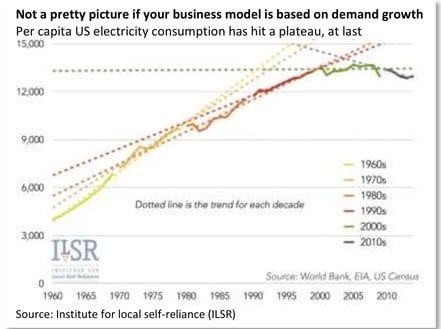For utility executives making New Year Resolutions, 2015 promises to bring in more grief in the form of lower demand growth, rising retail tariffs, and more competition from prosumers, who are consuming less due to energy efficiency gains, while producing more through small-scale distributed generation options. Utility executives, therefor, may decide to fight off the rapid uptake of solar PVs, or failing that, to join the competition in assisting more consumers to become prosumers – as a number of utilities have belatedly decided to do (article on page 21).
 For regulators, the challenge is how best to regulate, if regulate at all, as the stodgy, predictable and boring industry is going through a literal renaissance, as further described by developments in New York– which are closely watched byother regulators facing similar issues across the US and elsewhere.
For regulators, the challenge is how best to regulate, if regulate at all, as the stodgy, predictable and boring industry is going through a literal renaissance, as further described by developments in New York– which are closely watched byother regulators facing similar issues across the US and elsewhere.
For prosumers, however, the future is full of new and exciting opportunities that empowers them to do things that was barely imaginable a mere decade ago, most important, the possibility to generate clean, sustainable, non- polluting solar power on the rooftop at prices that meets, or in some cases beats, grid-supplied juice. If the cost of energy storage falls as rapidly as the cost of solar PVs did, connection to the grid will become nice to have – for backup, reliability and load balancing. It will no longer be necessary to buy large number of kWhrs from generators or distributors.
As several related articles in this issue further explain, utility business is becoming anything but business as usual. How the incumbent stakeholders and regulators respond to these changes will matter a lot. Prosumers, however, will increasingly do what is best for them, circumventing both utilities and the regulators if they get in the way of what is technically possible and economically advantageous.
Nonsense, you might say. Utilities have been around for over a century and they will manage to overcome the challenges facing them today, either by beating or joining their competitors. While some may in fact survive, and possibly thrive, many will be too slow to change or handicapped by the same regulations that have shielded them from competition for so long.
As described in the article on page 21, the speed and sheer magnitude of change is unprecedented. A recent report by Accenture says US utility revenues can be expected to fall some $48 billion by 2025 due to the double whammy of increased solar PV self-generation coupled with energy efficiency gains. Given that the industry collects roughly $360 billion per annum; such a loss represents a 13% loss in the sector’s revenues. Not devastating, perhaps, but neither pleasant.
The same message is conveyed in a special report on energy and technology titled, Let there be light, in the17 Jan 2015 edition of The Economist. It says, “Thanks to better technology and improved efficiency, energy is becoming cleaner and more plentiful – whatever the price of oil.”
Perry Sioshansi is president of Menlo Energy Economics, a consultancy based in San Francisco, CA and editor/publisher of EEnergy Informer, a monthly newsletter with international circulation. He can be reached at fpsioshansi@aol.com








